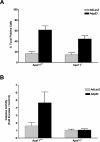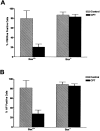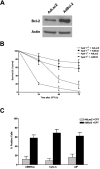Apoptosis-inducing factor is involved in the regulation of caspase-independent neuronal cell death
- PMID: 12147675
- PMCID: PMC2173837
- DOI: 10.1083/jcb.200202130
Apoptosis-inducing factor is involved in the regulation of caspase-independent neuronal cell death
Abstract
Caspase-independent death mechanisms have been shown to execute apoptosis in many types of neuronal injury. P53 has been identified as a key regulator of neuronal cell death after acute injury such as DNA damage, ischemia, and excitotoxicity. Here, we demonstrate that p53 can induce neuronal cell death via a caspase-mediated process activated by apoptotic activating factor-1 (Apaf1) and via a delayed onset caspase-independent mechanism. In contrast to wild-type cells, Apaf1-deficient neurons exhibit delayed DNA fragmentation and only peripheral chromatin condensation. More importantly, we demonstrate that apoptosis-inducing factor (AIF) is an important factor involved in the regulation of this caspase-independent neuronal cell death. Immunofluorescence studies demonstrate that AIF is released from the mitochondria by a mechanism distinct from that of cytochrome-c in neurons undergoing p53-mediated cell death. The Bcl-2 family regulates this release of AIF and subsequent caspase-independent cell death. In addition, we show that enforced expression of AIF can induce neuronal cell death in a Bax- and caspase-independent manner. Microinjection of neutralizing antibodies against AIF significantly decreased injury-induced neuronal cell death in Apaf1-deficient neurons, indicating its importance in caspase-independent apoptosis. Taken together, our results suggest that AIF may be an important therapeutic target for the treatment of neuronal injury.
Figures
















Similar articles
-
Apoptosis-inducing factor is a key factor in neuronal cell death propagated by BAX-dependent and BAX-independent mechanisms.J Neurosci. 2005 Feb 9;25(6):1324-34. doi: 10.1523/JNEUROSCI.4261-04.2005. J Neurosci. 2005. PMID: 15703386 Free PMC article.
-
Two distinct pathways leading to nuclear apoptosis.J Exp Med. 2000 Aug 21;192(4):571-80. doi: 10.1084/jem.192.4.571. J Exp Med. 2000. PMID: 10952727 Free PMC article.
-
p53-dependent caspase-2 activation in mitochondrial release of apoptosis-inducing factor and its role in renal tubular epithelial cell injury.J Biol Chem. 2005 Sep 2;280(35):31230-9. doi: 10.1074/jbc.M503305200. Epub 2005 Jun 27. J Biol Chem. 2005. PMID: 15983031
-
Role of mitochondrial proteins for neuronal cell death after focal cerebral ischemia.Acta Neurochir Suppl. 2004;89:15-9. doi: 10.1007/978-3-7091-0603-7_3. Acta Neurochir Suppl. 2004. PMID: 15335097 Review.
-
Apoptosis-inducing factor (AIF): a novel caspase-independent death effector released from mitochondria.Biochimie. 2002 Feb-Mar;84(2-3):215-22. doi: 10.1016/s0300-9084(02)01374-3. Biochimie. 2002. PMID: 12022952 Review.
Cited by
-
Olesoxime protects embryonic cortical neurons from camptothecin intoxication by a mechanism distinct from BDNF.Br J Pharmacol. 2013 Apr;168(8):1975-88. doi: 10.1111/bph.12094. Br J Pharmacol. 2013. PMID: 23278424 Free PMC article.
-
Incorporation of branched-chain fatty acid into cellular lipids and caspase-independent apoptosis in human breast cancer cell line, SKBR-3.Lipids Health Dis. 2005 Nov 23;4:29. doi: 10.1186/1476-511X-4-29. Lipids Health Dis. 2005. PMID: 16305741 Free PMC article.
-
Equine estrogens differentially inhibit DNA fragmentation induced by glutamate in neuronal cells by modulation of regulatory proteins involved in programmed cell death.BMC Neurosci. 2003 Dec 23;4:32. doi: 10.1186/1471-2202-4-32. BMC Neurosci. 2003. PMID: 14693041 Free PMC article.
-
Loss of caspase-2-dependent apoptosis induces autophagy after mitochondrial oxidative stress in primary cultures of young adult cortical neurons.J Biol Chem. 2011 Mar 11;286(10):8493-8506. doi: 10.1074/jbc.M110.163824. Epub 2011 Jan 7. J Biol Chem. 2011. PMID: 21216964 Free PMC article.
-
Non-Canonical Cell Death Induced by p53.Int J Mol Sci. 2016 Dec 9;17(12):2068. doi: 10.3390/ijms17122068. Int J Mol Sci. 2016. PMID: 27941671 Free PMC article. Review.
References
-
- Adams, J.M., and S. Cory. 1998. The Bcl-2 protein family: arbiters of cell survival. Science. 281:1322–1326. - PubMed
-
- Banasiak, K.J., and G.G. Haddad. 1998. Hypoxia-induced apoptosis: effect of hypoxic severity and role of p53 in neuronal cell death. Brain Res. 797:295–304. - PubMed
-
- Cecconi, F., G. Alvarez-Bolado, B.I. Meyer, K.A. Roth, and P. Gruss. 1998. Apaf1 (CED-4 homolog) regulates programmed cell death in mammalian development. Cell. 94:727–737. - PubMed
-
- Cheng, Y., M. Deshmukh, A. D'Costa, J.A. Demaro, J.M. Gidday, A. Shah, Y. Sun, M.F. Jacquin, E.M. Johnson, and D.M. Holtzman. 1998. Caspase inhibitor affords neuroprotection with delayed administration in a rat model of neonatal hypoxic-ischemic brain injury. J. Clin. Invest. 101:1992–1999. - PMC - PubMed
Publication types
MeSH terms
Substances
Grants and funding
LinkOut - more resources
Full Text Sources
Medical
Molecular Biology Databases
Research Materials
Miscellaneous

